Understanding the Australian Shepherd colors might seem like an almost impossible task to many, but after you read this article, I’m sure it’ll all be as clear as day.
These pups have been making thousands of people happy from Australia to the United States for decades, and will do so for the next few hundreds of years, as well!
There’s a popular theory that Aussies are descendants of Border Collies, which would explain why they look so similar and why Aussies have herding dog instincts.
However, there’s still a great discussion going on between experts, so this claim is still not substantiated.
But, what we do know for sure are the differences between the coat shades of Australian Shepherds, and we’re ready to share our knowledge with you in the paragraphs below!
Standard Australian Shepherd Colors
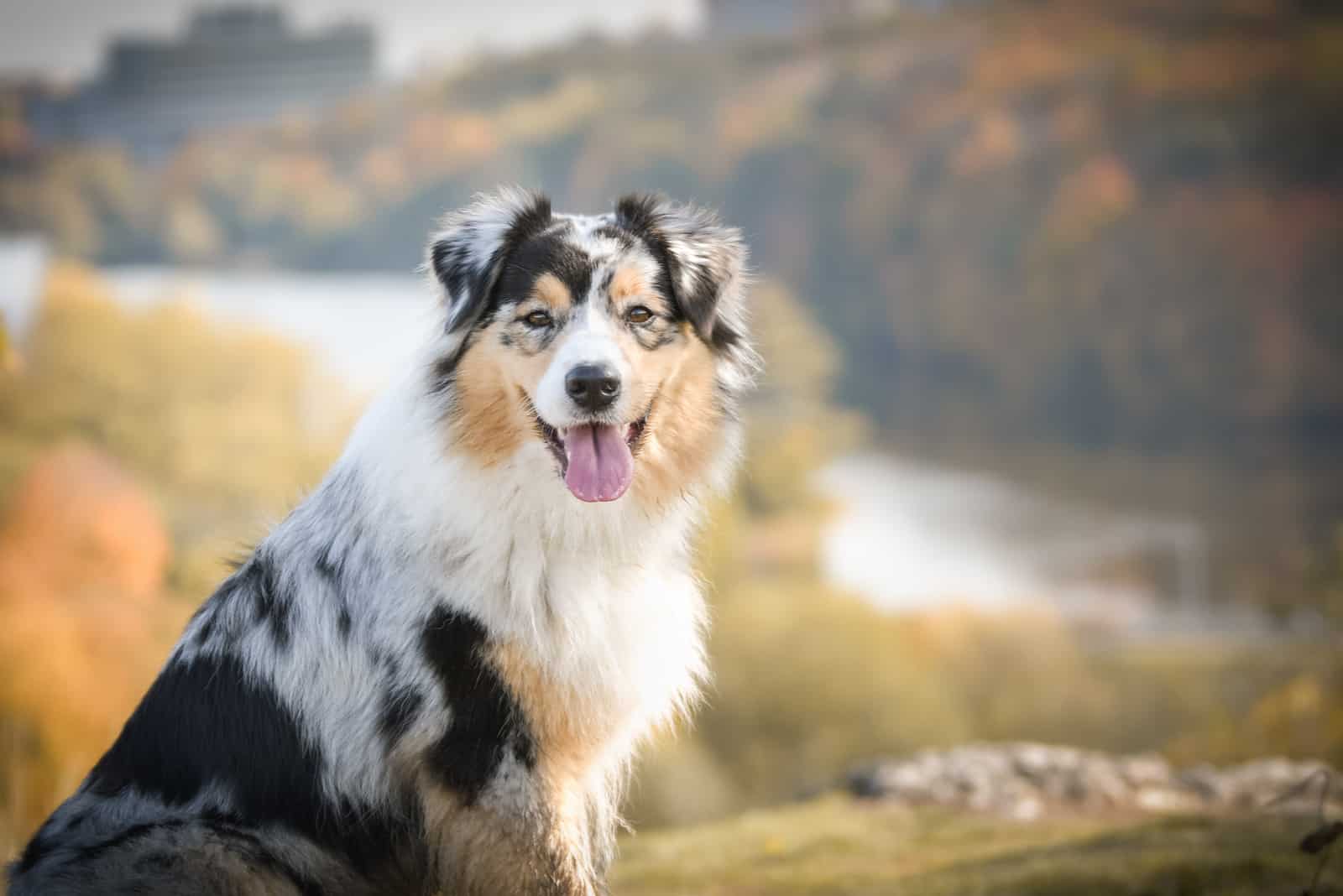
It’s impossible to make a list of Aussie colors and patterns without classifying them into categories of standard colors and rare colors. Rare colors are those that are still not acknowledged by the major canine organizations and associations, including the United Kennel Club, the American Kennel Club, the United States Australian Shepherd Association, etc.
Aussies that have shade combos different to the ones listed in this article, can’t be considered purebred Australian Shepherds.
There are four shades that are formally accepted as Australian Shepherd colors. All canines with coats of hues other than the four mentioned below, are referred to as mutts (crossed with different types of canines):
• Red
• Red Merle
• Blue Merle
• Black
These four shades are considered the main coat colors, from which the other ten types can be made. Of course, these Aussie shades aren’t the only hues of this dog breed, but they comply with the American Kennel Club’s (AKC) breed standard.
Red Aussies
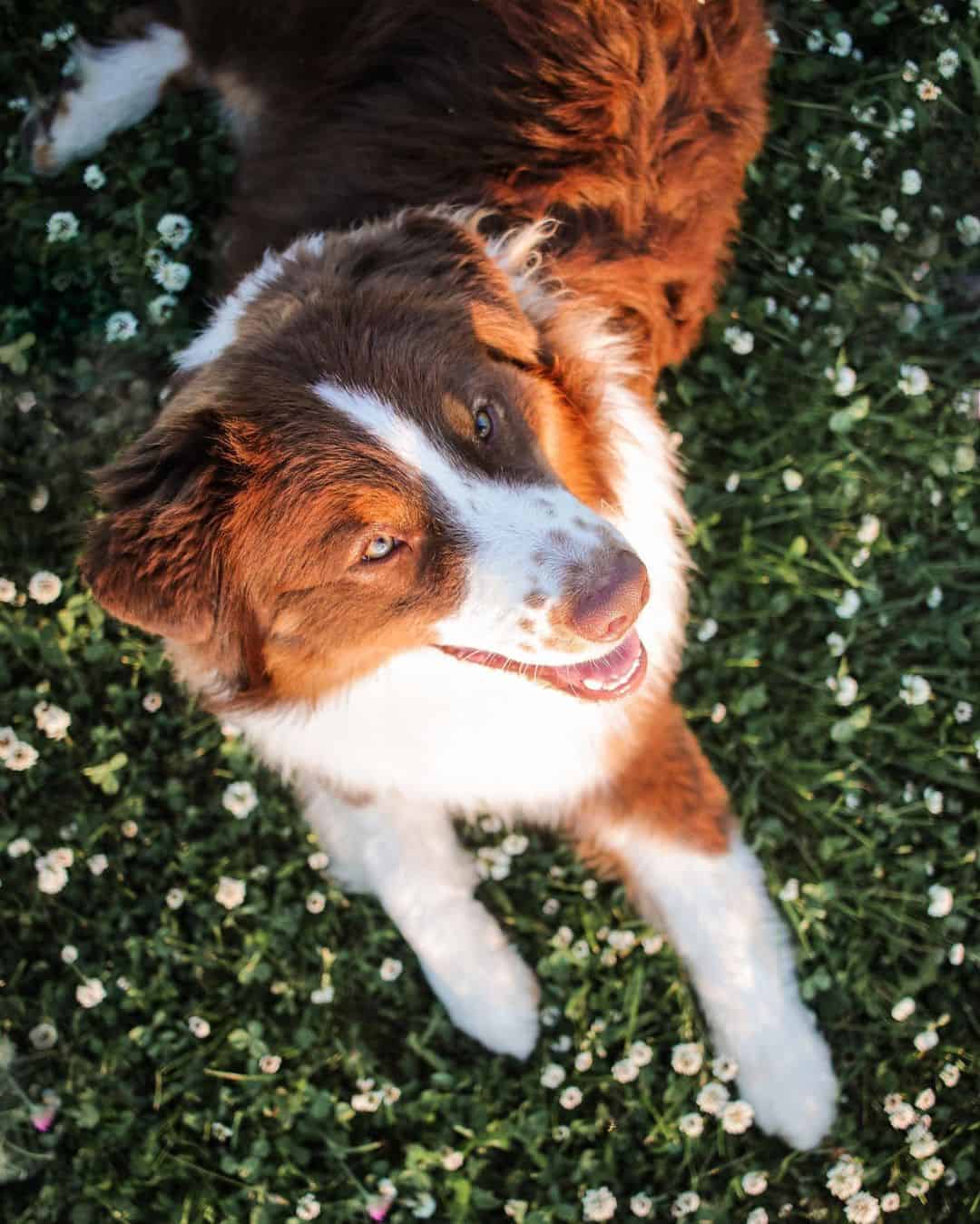
Photo from: @apollostrail
The red Aussie canines are quite common in three distinctive color types:
• Solid red
•Red-bi
•Red-tri
All of these color options are up to the breed standard and can be used in conformation events and dog competitions.
Solid Red
Solid red Aussies are quite unpopular among breeders and dog owners, mostly because they’re considered “too common”, compared to the other shade variants.
Unfortunately, many people disregard the temperament and all the great qualities of a canine, just because of their visual appeal.
Solid red pups are undeservedly disregarded as potential candidates for family pets or show canines, just because they don’t seem as interesting as Aussies of other colors.
In case you get the opportunity to own one, I’d strongly suggest you give a red Aussie a chance, I’m sure you’d love them!
The fact that red Aussies are so uncommon gives these puppies the potential to be the most distinctive of all the colors. It also gives you a chance to own a unique pooch!
Red-bi
Essentially, red-bi Aussies are actually a red and white breed (because this combination is the only red-bi variation allowed by the AKC).
The basic color of these pups’ coats is red, while white is often present on the chest, head, and legs of the animal.
Those who have had a close look at this coat type will agree that a tan or brownish shade can be seen in traces. However, the amount of tan marking is really toned down, so it’s possible to classify those pups as red and white Australian Shepherds as well.
This type of Australian Shepherd has been in high demand during the last decade and might become even more popular in the future.
Red-tri
This type of Australian pup is one of the most exquisite red shades and is very popular, even though they’re not a very common sight to see!
The red tricolor Australian Shepherd is characterized by a red base coat, which can be anywhere from a mild orange-like red to a deep red color (also known as the liver shade).
It doesn’t really matter which part of the color wheel it belongs to, as long as the shade seems to be “red” in color, it’s perfectly fine.
Of course, this wouldn’t be called a tricolor if there wasn’t three shades on the coat, right?
Well, the second hue on the Aussie’s coat is the white hue, which appears in spots that are placed on the stomach, head, legs, and chest.
This red and white combo is decorated with a sprinkle of copper shade, which accentuates certain parts of the Australian Shepherd’s legs and face.
Australian Shepherds with chest parts in a copper shade aren’t very common, but they’re not non-existent either!
Red Merle Australian Shepherds
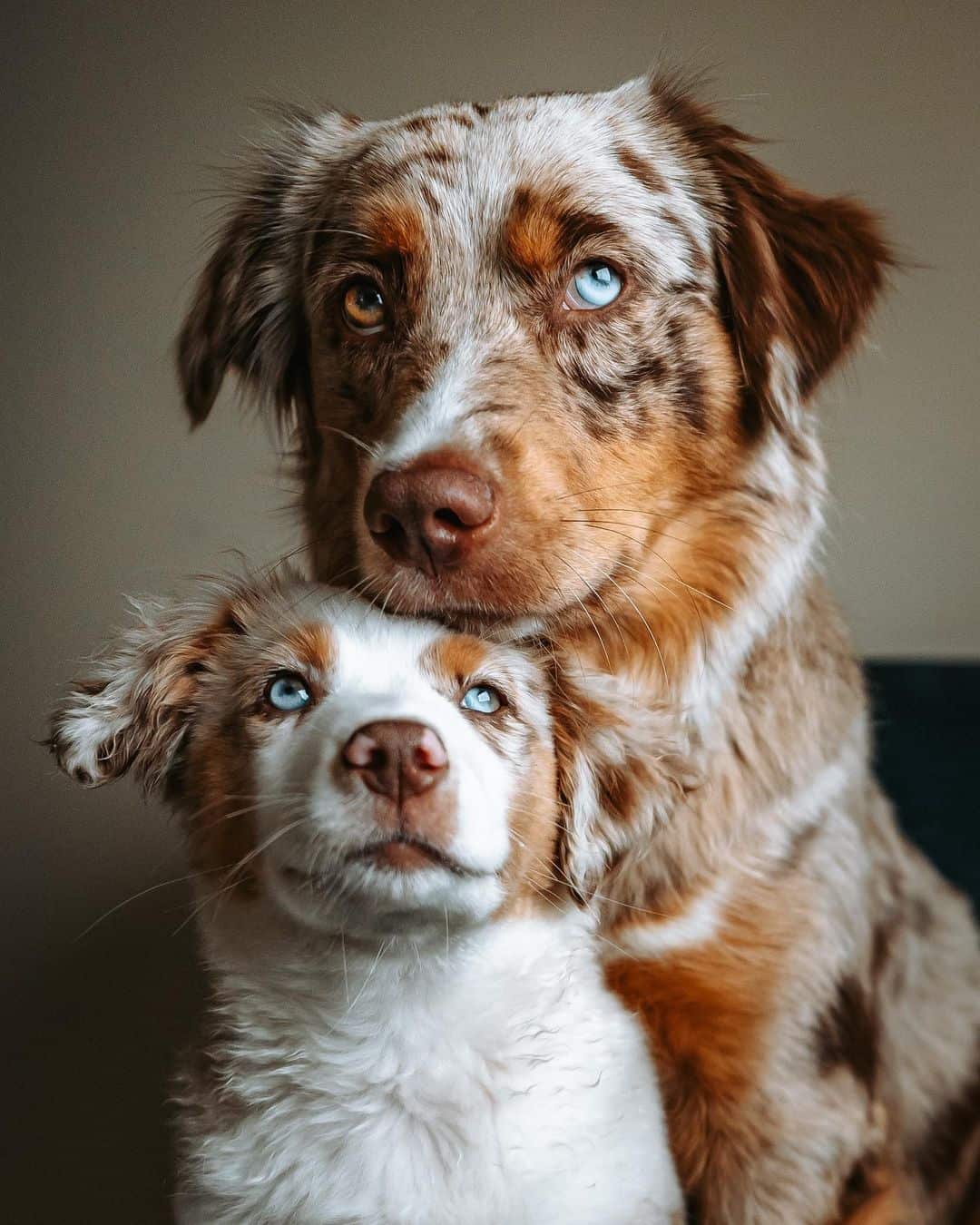
Photo from: @the.radas
There are three distinct variations available within the red merle category, all following the same patterns as the red Australian Shepherds.
The red merle shades are classified as:
• Solid red merle
• Red merle and white
• Red merle tricolor
Puppies from the red merle category have a unique appearance, just like their blue merle counterparts, which proves that the merle pups are just as beautiful and worthy as other colors and patterns.
Solid Red Merle
The solid merle puppy is fairly comparable to the other coat shades and patterns from the red merle category.
There is a broad array of variability in the hue, shape, and form of the red patches. Depending on the canine, the patches might range in size from discrete specks to extensive blotches.
There are a lot of canine owners who believe that red merle Australian Shepherds are indeed red merle and white pooches.
Even though this could be considered a subjective opinion, which everyone is entitled to, there’s a significant difference that might put an end to this dilemma.
The fact is that the merle pattern of solid reds is more equally dispersed across the Australian Shepherd’s body than it is in the red merle and white canines.
The Eye Colors Of Red Merles
These pups indeed have a very unique visual appearance, not only regarding their coat shades but also when it comes to the colors of their eyes.
The majority of red merle dogs possess eye shades that are solid. However, there are certain pups that might have a sort of “marbled” eye pattern.
This phenomenon isn’t related exclusively to red merle Aussies, but the blue ones as well.
These canines have a complete one-of-a-kind appearance because of their marble look, which is a term used for spots of various shades.
Basically, red merle Australian puppies can have brown or blue eyes. Those with a blue shade will have brown-like dots, and if your red merle pup has brown eyes, you can expect it to get blue dots, too.
Heterochromia
Aussie puppies with the red merle gene can also have heterochromia, a condition where a pup has two different eye colors. For example, there are red merle pups that have one hazel-like and one blue eye.
The blue eyes are actually the result of heterochromia because they signify a deficiency of melanin.
Red Merle And White
White and red merle are the only shades that are allowed in this color category, which is no surprise, considering the same goes for solid red and white Aussies, too.
It might be quite challenging to detect the difference between the red merle bicolor and the tricolor pups, but it’s not impossible.
There are occasions when the base hue of a red merle can have a very strong resemblance to the white color.
Therefore, it is reasonable to assume that there will be a certain degree of misunderstanding involved when categorizing these variants.
Essentially, we can all agree that both of these coat types are beautiful and I’m sure that none of the future owners would mind owning either of these adorable pups.
Red Merle Tricolor
The basic coat color (the undercoat hair) of this tricolor type is a red merle shade, which is also considered the primary of the three hue components.
These puppies feature red specks on top of a base hue that ranges from silver to buff (a pale cinnamon type of color).
The tricolored variant includes white patterns on the head, chest, legs, and stomach area.
Red merle tricolors contain copper spots, which are usually only visible on certain parts of the face and legs.
Red merle tricolor Aussies are out of this world when it comes to physical appearance, but their temperament is just the same as the other pups of this breed.
If you like the way they look, you can get yourself a red merle tricolor, I’m sure your pup will turn a lot of heads during your everyday walks.
Blue Merle Australian Shepherds
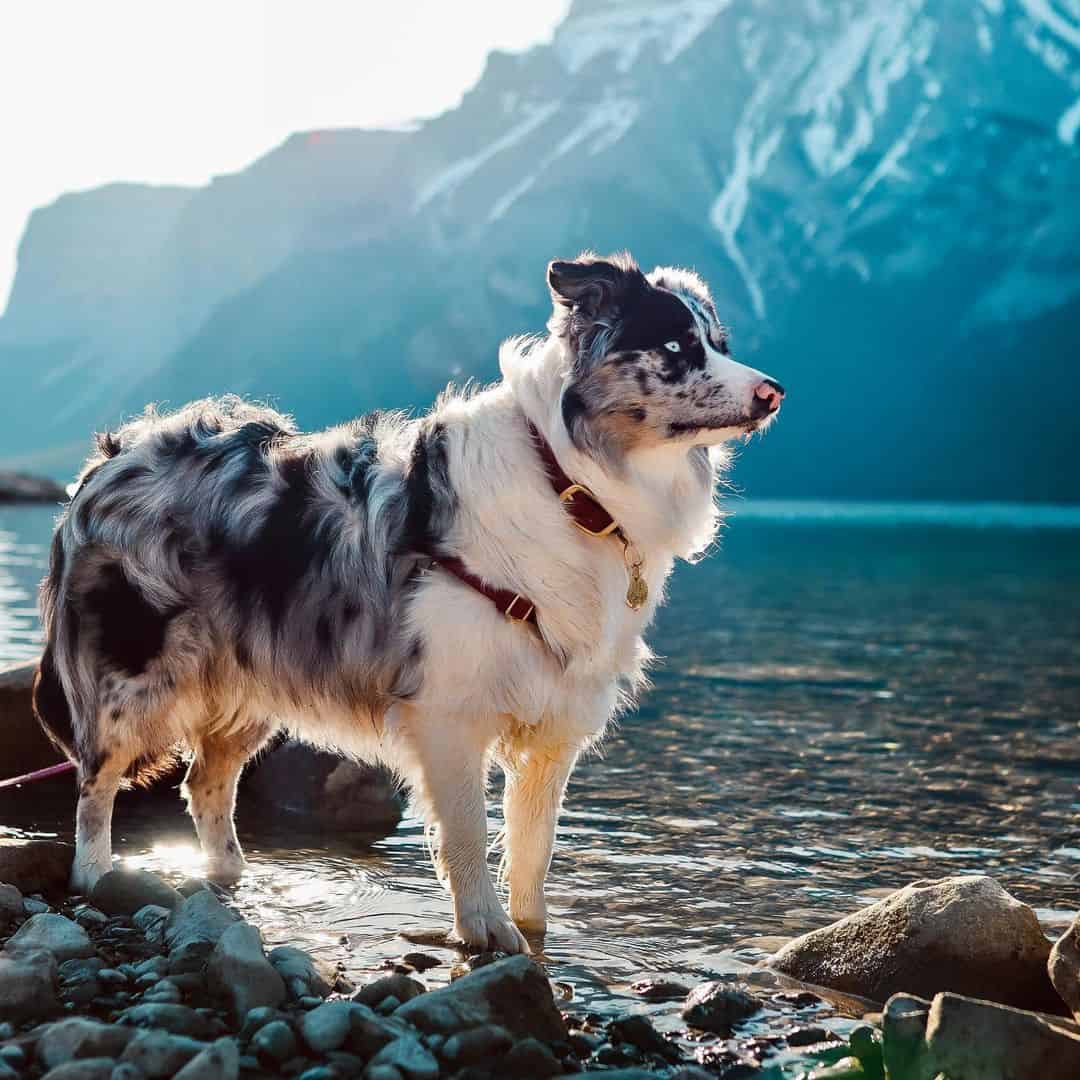
Photo from: @hi.itsme.luna
Aussies with blue merle coat patterns are definitely the most unusual and distinctive among the four main shades of this magnificent canine breed.
However, that’s not all! This rare pattern category can be divided into four different sections.
All I can say is that each one of them is breathtaking in its own way!
The blue merle colors are classified as:
• Solid blue merle
• Blue merle and tan
• Blue merle and white
• Blue merle tricolor
Every hue from this list will be explained in detail in the next few paragraphs.
Solid Blue Merle
As we said previously, blue merle serves as the basic shade for the coat of this particular Aussie type.
This hue consists of a coat that is gray overall and it has patches of black in various places.
This type of coloring produces a blueish kind of shade, also known as the blue effect, which is where these pups get their name from.
While the gray might look anywhere from silver to a dark, shadow-like gray, the black dots can be as little as spots or as vast as large patches.
For this reason, blue merle Aussies are considered as intriguing and one-of-a-kind canines.
You won’t come across a rich blue merle very often, but once you do, they will steal your attention because they’re quite stunning to look at.
Eye Colors Of Blue Merle Australian Shepherds
In most cases, blue merles have single-shade eyes, mostly in hazel or a chocolate hue. However, in some cases, their eyes will have flecks of hues that aren’t typical (marble eyes).
Essentially, this eye shade pattern is very similar to the red merle Australian Shepherds.
This means that the blue merle Aussie pups are prone to have brown or blue-colored eyes, with a possibility of heterochromia.
Blue Merle And Tan
The appearance of a blue merle with orange or tan markings is a somewhat unusual sight.
This combination often includes white colors as well, usually in smaller patches or spots.
Despite their rarity, there are still instances of this combination occurring in Aussie litters. The uncommonness of this type is what keeps their prices pretty high.
Blue Merle And White
This version of the blue merle Australian Shepherd is one of the shades that are high in demand.
When the pup’s coat is covered by a blue merle pattern but includes just white markings, it’s classified as a blue merle bicolor type of Australian Shepherd.
The head (eye rims, part of the muzzle, and nose), the legs, and the chest are the most common locations for these marks.
Even without copper coloring, these canines have the same spectacular appearance as the tricolor Australian Shepherds.
However, these pups are known for another reason as well. Many canine owners, especially those with less experience, might confuse blue merle bicolor pups with Huskies!
Indeed, Huskies share a similar color pattern as blue merle Aussie puppies. Blue merle puppies have the same eye color types as Huskies, as well!
However, once you take a closer look at their body and head shapes, you’ll notice all the differences between them!
Blue Merle Tricolor
Of all these types, the Blue Merle Tri Aussie is the one that appeals the most to a large number of Australian Shepherd enthusiasts.
These pups are gifted with such a stunning assortment of colors, that people who walk by can’t resist stopping and looking at them in admiration.
These canines have a blue merle undercoat, which is characterized by black dots in any form or size, distributed over a solid gray coat.
This blue merle pattern is decorated by patterns of white and reddish-brown shades that are concentrated around the ears and muzzle, legs, stomach, and part of the chest.
As a result, you get one of the rarest and most beautiful puppies, a tricolor blue merle Aussie.
Black Australian Shepherds
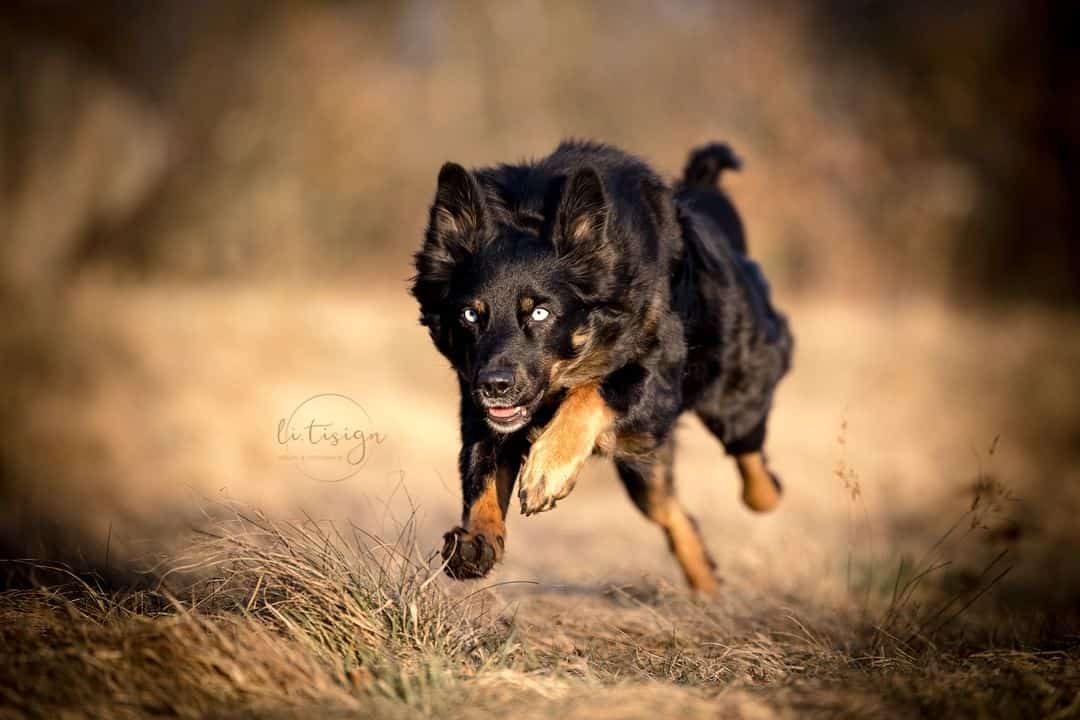
Photo from: @li.tisign
There are four distinct varieties of black Aussies, and each one has a unique coat color pattern.
The black-coated Australian Shepherds are classified into four different categories:
• Solid Black
• Black and Tan
• Black and White
• Black Tricolor
Solid Black
Solid black Aussies have almost no signs of red, brown, or white on any parts of their bodies.
Just like the majority of solid shade Aussies, black Australian Shepherds aren’t exactly the most sought-after pets, but they might occasionally be found in some litters.
A black Australian male or female canine may occasionally have a very slight trace of white on their chest, just below their neck.
Despite the presence of this tiny white marking, most people will continue to refer to the dog in question as a solid black Australian Shepherd.
Eye Colors Of Black Aussies
The Australian Shepherd’s eyes can be colored in beautiful solid colors or an unusual blend of blue and brown, which is one of the breed’s most endearing characteristics.
Despite this, the majority of black Australian Shepherds, regardless of their color patterns, have both eyes in the same shade (usually a dark/light hazel hue).
Even though it is conceivable for Australian Shepherds to have eyes with different hues, this trait is rather uncommon.
Black And Tan
This type of coat is considered highly unusual for Australian Shepherds, but it might appear in certain cases.
The black and tan Aussies possess a black coat with tan, beige, or reddish-brown patches on their legs (including paws), parts of the chest, neck, around the muzzle, and around the eyes (in certain cases).
Most people will agree that this type of Aussie shares the same or similar colors to Rottweilers, Dachshunds, Jagdterriers, Dobermans, Beaucerons, and others.
RELATED: Long-Haired Rottweiler: Genetics, Care, And General Info
Black And White
This type of black coat isn’t the most common shade among Australian Shepherds, but it’s not much rarer than the tricolor black Aussies.
These pups are also known as black bi pups because of the two colors present on the Aussies’ coats.
In most cases, the only parts of the pup that have white patches are the stomach, neck, muzzle, and part of the top of the head, along with different parts of the legs.
These canines are, indeed, very similar to the next type of Aussie we‘ll discuss in the paragraphs below – the only difference is the lack of a third shade in bicolor Aussies.
Black Tricolor
This is probably one of the most typical and primary color combinations of an Aussie canine.
The tricolor pattern usually includes three different shades: white, tan, and black.
The hues of Aussie pups remind us of the Bernese Mountain Dog colors, although they don’t have the same patterns.
The black coat is frequently accented by white patches on the legs, stomach, chest, and head (muzzle and the top of the head).
On the other hand, orange or tan points can occasionally be seen on parts around the eyes, and around the white spots on the coat.
Both short and long-haired black tricolor pups are a good fit for dog shows and conformation events.
On the other hand, each black Aussie may have a different distribution and intensity of a certain hue. That is what separates them from other pups.
Non-Standard Australian Shepherd Colors
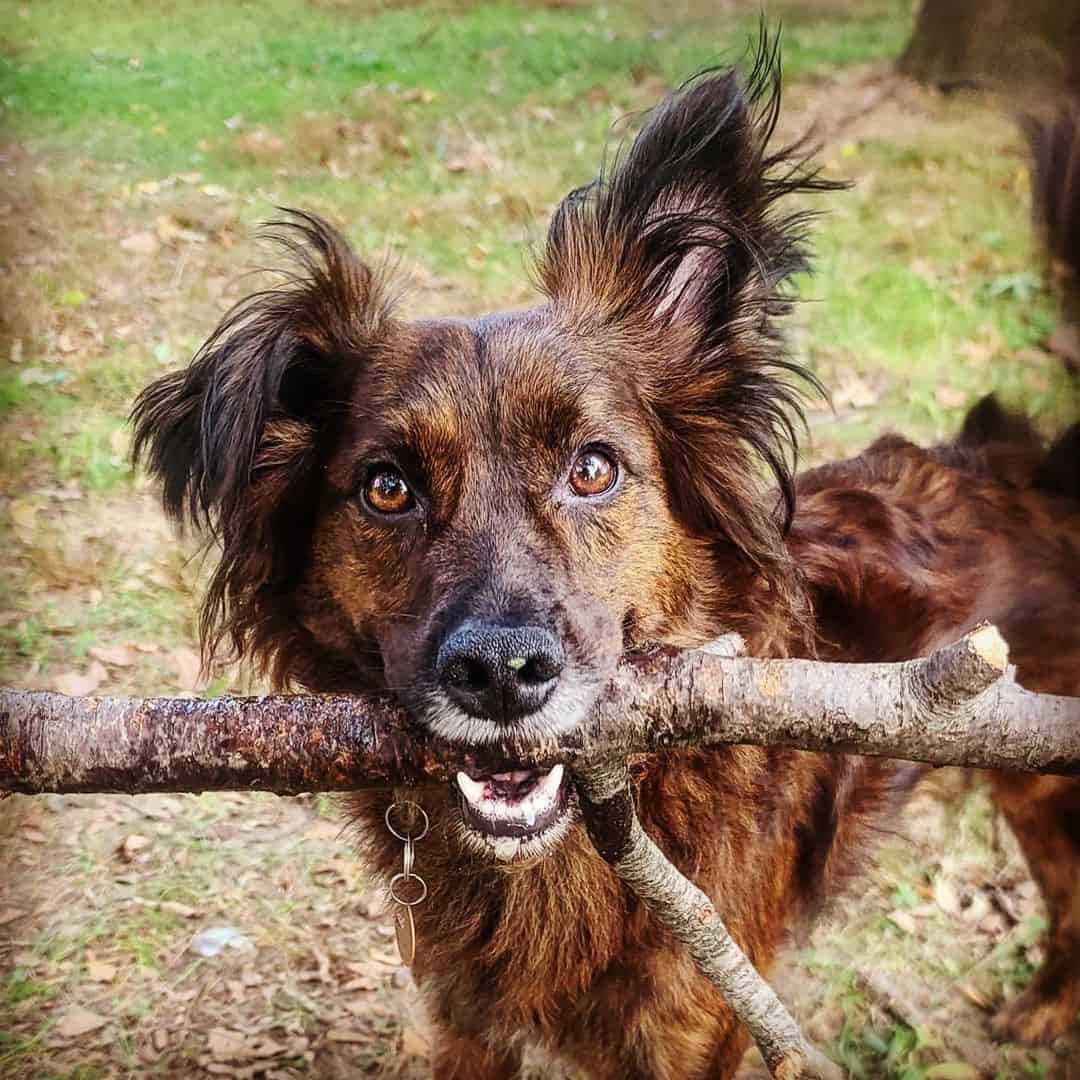
Photo from: @thewalkingpoofs
The majority of Australian Shepherd pups belong to one of the four primary categories of Aussie colors, which all comply with the AKC breed standard.
However, it’s not impossible to come across an Australian Shepherd breed that possesses a different type of coat.
The colors and patterns that aren’t officially up to the standards of Australian Shepherds are:
Brindle
This coat pattern is characterized by a reddish-brown basic coat color and black tiger-like lines over it.
With this type of pattern, brindle Aussies definitely stand out from other pups, but it’s important to mention that this coat type never includes any traces of white color on it. If there’s any white on the coat, it’s a bi or tricolor Aussie.
White
In comparison to other single-shade canines of this dog breed, completely white Aussies are a very unusual, almost unique sight.
The reason for this is that the white color comes from a recessive gene that appears in extremely rare cases in Australian Shepherds.
In order to get a white Aussie puppy, a breeder will need two Aussies that are carriers of this gene because that’s the only way of passing down this unique pup color.
A white canine with darker coloring in their eyes and a black nose is considered a regular white Aussie Shepherd.
However, if the white color is followed by a pink-like nose and blue eyes, there is a high chance that you are in possession of an albino canine.
Do White Aussies Have More Health Problems?
Unfortunately, white Aussies, just like other white pups, are rarely intentionally bred because of all the health issues that are related to the white color gene.
Canines that are completely white or have prominent white markings (such as doublemerles) are thought to be prone to hearing loss and skin cancer.
Of course, the lack of pigmentation doesn’t always mean that the dog will have any of the conditions mentioned above, but they should be regularly examined.
Brown
Because of their similar appearance, red and brown Aussie Shepherd pups are often confused with one another, which is completely understandable as their shades do look almost identical.
However, the brown pigment in this type of coat is more earthy-toned than in the red shade, which is more of a copper-like color.
However, there are certain Aussies with deeper brown shades, such as the chocolate one, but most importantly, no matter which brown they’re colored with, no other marking on the coat is accepted (tan or white).
Sable
This type of coat is quite rare and a non-official color among Australian Shepherds. It is made up of black speckles on coats of brighter colors, such as the red, tan, or brown strands of hair.
The sable gene is very uncommon in Aussies, but it’s quite common in the partially same-named pups, German Shepherds, which is why sable GSDs are officially acknowledged by the AKC.
Yellow
Another type of Aussie with a recessive gene is the yellow pup, which dilutes the color of the coat, but not of the nose.
That’s exactly how you’ll know whether your pup is a dilute color, such as beige, which is similar to yellow but has a diluted nose color.
This type of color can be anything from pale yellow to the deeper golden shade, such as the color of the Golden Retriever.
READ NEXT: Show Golden Retriever Vs. Field Golden Retriever – Understand The Differences
Fawn and white
If an Australian Shepherd dog receives brown and red color genes along with diluting ones, you will likely end up with a fawn and white pup.
The brown or red wash out, thanks to the dilution gene, to the point where they look fawn rather than their original hues.
Although they’re unusually colored pups, yellow Aussies don’t have higher risks for certain diseases than their different colored counterparts.
However, regular checkups and health tests are always a good idea, even if your pooch seems completely healthy.
What Is The Rarest Australian Shepherd Color?

Photo from: @mavetheaussie
The red color is one of the rarest colors of Australian canines in general, although the merle pattern seems to be in the lead when it comes to the most unique Aussie coat types.
Of course, this is if we’re talking about the AKC-recognized shades of this working dog breed.
However, one of the rarest shades of Aussies is any type of dilute color (blue or liver, with a changed color of the nose).
These pups, along with the ones whose white stripes go over the withers, are considered faulty by the major associations, including the AKC, the United Kennel Club, and the Australian Shepherd Club of America, among others.
Wrapping Up
The categorization of Australian Shepherd colors is somewhat distinct from other dog breeds and I hope that this article has helped you to understand the fundamental dissimilarities between black, blue merle, red, and red merle pups.
This wonderful canine will steal your heart in a matter of seconds, regardless of its coat colors, because of the traits that both the standard and mini Aussies possess!
Aussies are great with children, but they’re also good at keeping your home protected at all times.
However, if you want an Australian Shepherd of top quality, you will need to get one from a reputable breeder of Aussies rather than pet stores, puppy mills, and other unethical breeders.
READ NEXT:
Toy Australian Shepherd: Your Guide To The Toy Aussie Dog
Australian Shepherd Growth Chart: Your Guide To Aussie Puppy Growth
Top 9 Australian Shepherd Breeders In Texas – Choose Your Aussie!















